What was idolatry--like, really?
Did humans ever carry around little dolls and believe the dolls to be gods?
I’ve been genuinely befuddled by the drawings (btw: I love the drawings in the Good News Bible!) of ancient people worshipping idols that I first noticed in my Bible almost two decades ago. Check them out:
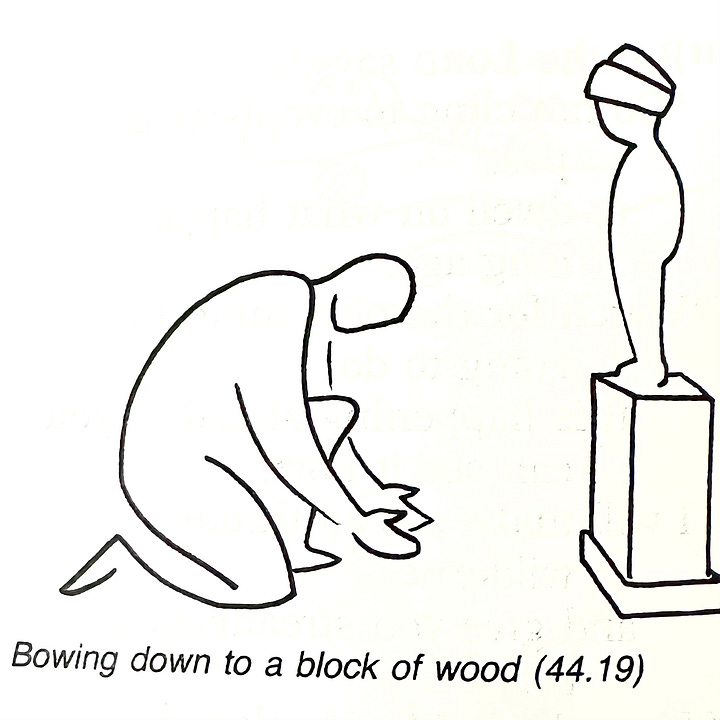
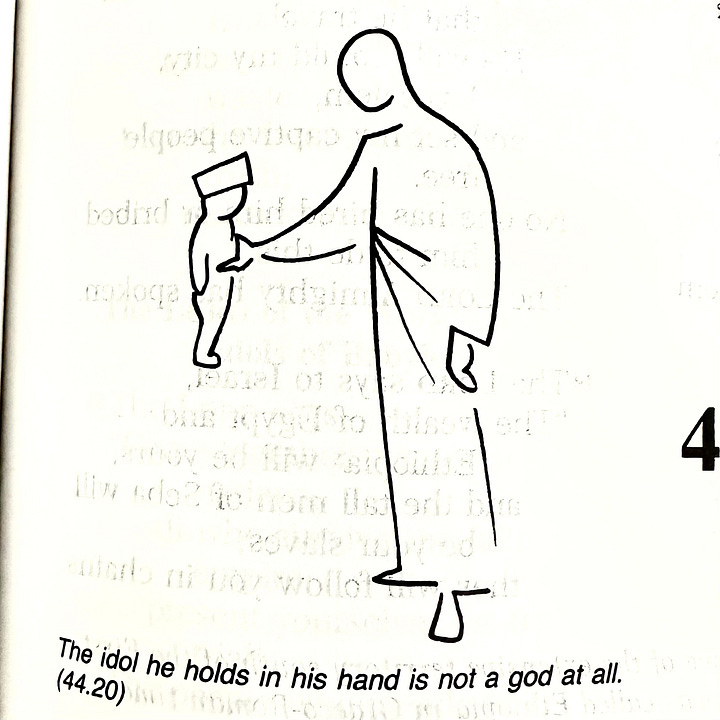
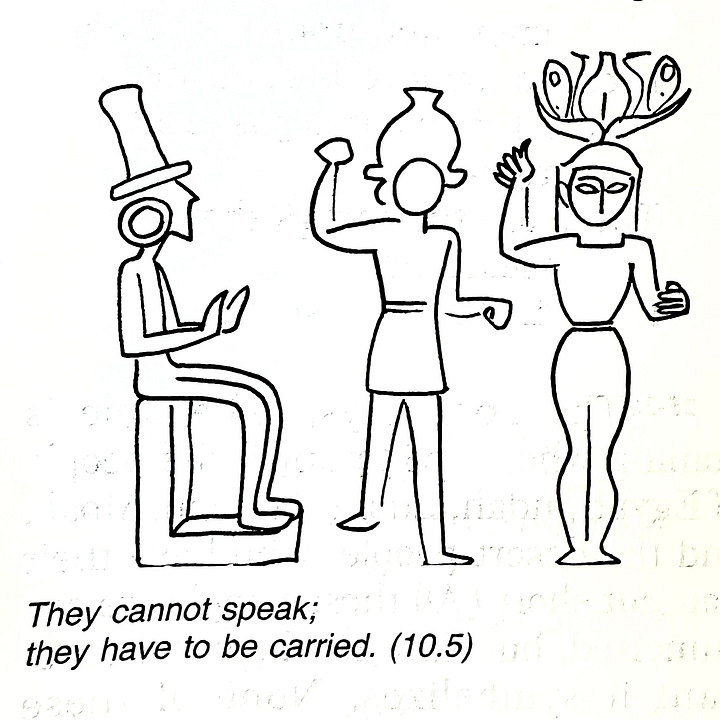
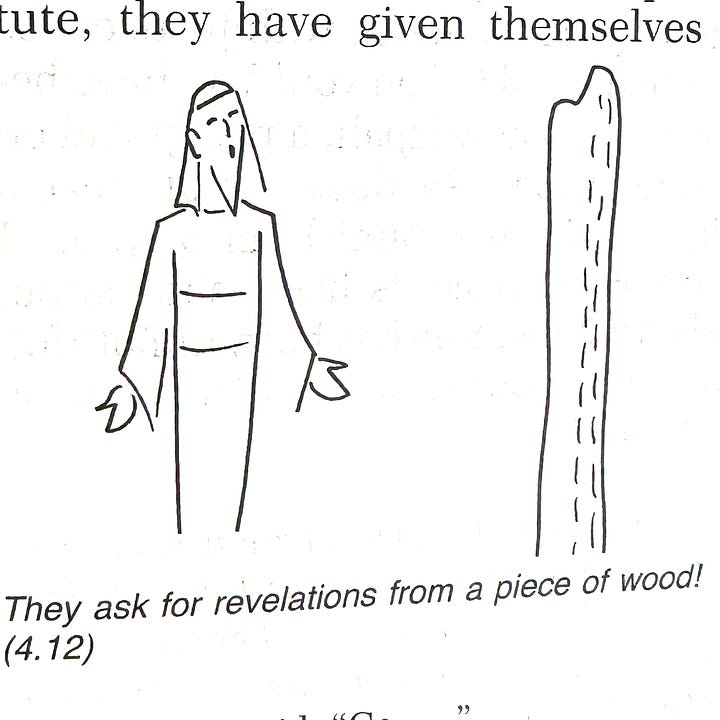
The one that really gets to me is the one where the guy is holding an 18” statue that he supposedly believes is a god. The drawing just seems so implausible to me. In fact, I’ve struggled to understand why other people—other Christians—aren’t similarly perplexed by this narrative. And to be honest, I’ve concluded that they just aren’t thinking about it very hard.
Isaiah’s ridiculing of Idolatry (Isaiah 44) seems to involve admonitions against both Babylon (presumably where the practice originated) and the people of Israel, who have taken up the practice themselves.
Don’t misunderstand me: I’m not saying that it’s implausible that Babylonians might’ve carved statues of their deities and used them as objects of veneration. Putting a plastic statue of Mary on the dashboard, even bowing before a crucifix, these things we understand to be referential—and it’s easy to imagine that the Babylonians might’ve had wooden or metallic idols of Enlil, Anu, Marduk, or whoever. The implausible part is the implied accusation against them that they believed these statues themselves to be deities.
Quoting from my Good News Bible (Today’s English Version), Isaiah’s voice is very conversational:
With some of the wood he makes a fire; he roasts meat, eats it, and is satisfied. He warms himself and says, ‘How nice and warm! What a beautiful fire!’ The rest of the wood he makes into an idol, and then he bows down and worships it. He prays to it and says, ‘You are my god — save me!’ Such people are too stupid to know what they are doing. They close their eyes and their minds to the truth. The maker of the idols hasn’t the wit of the sense to say, ‘Some of the wood I burned up. I baked some bread on the coals, and I roasted meat and ate it. And the rest of the wood I made into an idol. Here I am bowing down to a block of wood!’ It makes as much sense as eating ashes. His foolish ideas have so misled him that he is beyond help. He won’t admit to himself that the idol he holds in his hand is not a god at all.
I wonder if you can see the problem here the way I see it. The issue is not whether ancient peoples made statues and appeared to worship them. They certainly did. The question is whether their practices were any different from the common Christian practices that emerged a thousand years after Isaiah. See for instance:
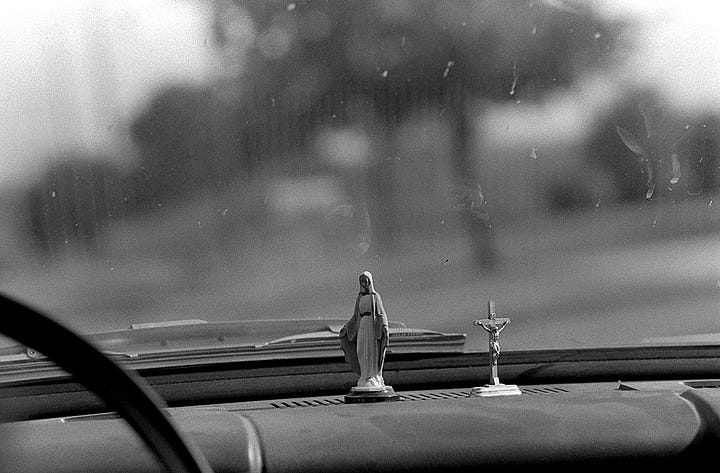



There simply is not an observable difference from an ethnographic perspective. But of course, we all know the knee-jerk reply from Roman Catholics: “no no no, this is very different. Unlike the Babylonians, we understand that our statues are merely blocks of wood. We understand that they are not themselves gods. We just use them as teaching tools. Our statues help us recall the real figures, and ultimately the deity, that we worship.”
I think it was in Mere Christianity or Surprised by Joy that C.S. Lewis developed the idea of chronological snobbery, where we very sophisticated people of the present believed that we were intellectually superior to all peoples of the past merely because — well, because we live in the present. And to my eye, that appears to be the case in this matter. It is easier for us to imagine that ancient people were like kindergarteners than it is for us to acknowledge the eerie and exact parallels between practices Isaiah condemned and our own practices.
In fact, even today, you’ll hear accusations from Christians (who themselves regularly venerate icons, bow down to statues) that Hindus “worship idols.” But outwardly, viewed impartially, there is no difference.
This morning I read a 2006 article in the Journal of the History of Ideas by Rubiés titled, “Theology, Ethnography, and the Historicization of Idolatry.” Here’s a link. His opening paragraph makes most of the point:
Idolatry apparently died in the writings of one of the leading writers of the
Enlightenment. Voltaire argued in his Philosophical Dictionary that idola-
try is a false concept without analytical value, as no nation ever worshipped
idols as such, but always a deity represented by them: ‘‘there has never been
a people on earth who has adopted this name of ‘idolater.’ This word is an
insult, a term of outrage.’’1 Gentiles used images to represent deities in the
same way as many Christians used images to represent God—and Catholics
were guilty in particular of appearing like ‘‘idolaters’’ with their cult of
saints; the fact that only Christians truly worshipped God could be equally
applied to many Gentiles who had been accused of idolatry. Hence the
charge of idolatry only had a rhetorical meaning, as if to say, ‘‘your gods
are false, and mine is true.’’
Lately, I’ve been hankering to buy some ancient Roman coins, but I can’t afford to yet. I want a denarius with Tiberius on it, of course, and maybe a tetradrachm with an Athena Owl. But looking at one of the auction websites, I got to thinking — I wonder if there are any ancient idols for sale? Surely if there were 18” metallic statues of deities all over the Mediterranean and Middle East, a few would have been recovered? But they’re hard to find. Maybe they’re all in museums. In any case, what Voltaire said seems true to me: to the extent that ancient peoples made little statues of gods, they were not doing anything different than modern Christians do.
Keep reading with a 7-day free trial
Subscribe to An Altar of Unhewn Stone to keep reading this post and get 7 days of free access to the full post archives.

